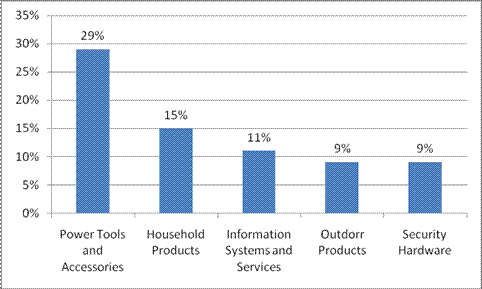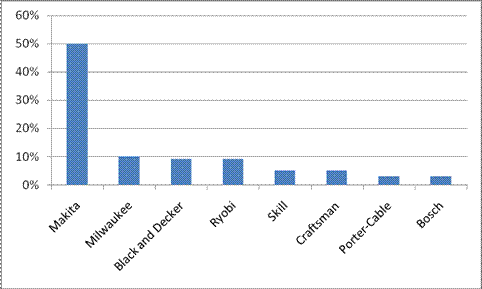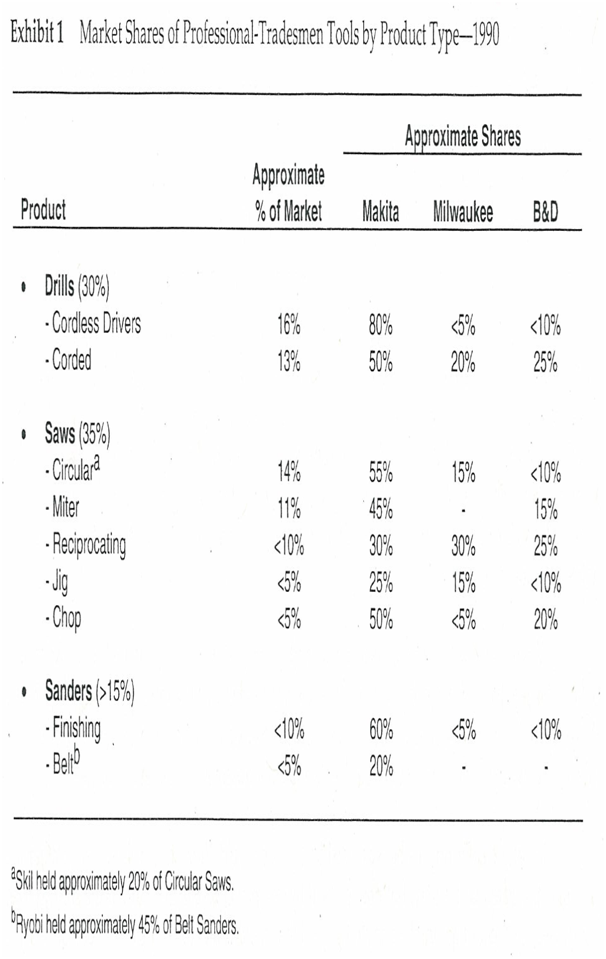Marketing Management Assignment Answer
1.1 Problem Statement:
The problem faced by the Black and Decker Corporation (A) is the zero profitability faced by the company in its Power Tools Division’s especially in the ‘Tradesmen” segment. Out of the three segments in this Power Tools Division, B&D; was facing immense competition from Makita Electric of Japan which had practically taken oven the professional power tools for tradesmen business since it entered the United States market a decade ago. According to the trade practices the company needs to allow advertising allowances and rebate money on B&D;’s Tradesmen products as the profitability in this segment was near to zero. The senior management of the company has resolved to challenge Makita for leadership in this segment and put an end to this “no win” game by developing and gaining corporate support program, but he could realize the sensitivity of the issue of capturing the market, where the B&D; is just 9% with near to zero profitability.

1.2 SWOT Analysis:
B&D; is the world’s largest producer of power tools; power tools accessories, electric lawn and garden tools and residential security hardware. The company primarily started as a power tool company but gradually moved from ‘garage to the house’ after introducing the most successful hand held vacuum cleaner. This allowed the company to purchase the Housewares Division of General Electric’s for $212 million and use its name on its products but till 1987 only. Another acquisition of Emhart Corporation in 1989 gave a tremendous impetus to B&D; and not only doubled the revenues of the company but also facilitated the emergence of strong brand. The negative consequence of this acquisition is that it raised the debt levels of the company to 84%. Out of the total Power tools market which constitutes 30% market share in US, 35% was constituted by consumer tools section and the remaining 65% was constituted by for work market. The company is doing quite well in the other two segments of Power Tools division but facing huge problems in the Power tools, Professional –Tradesman segment (Appendix 2)
1.2.1 Strengths
One of the biggest strength of the company is the large number of divisions, then segments and then products groups of the business. This wide portfolio comprising of a large number of products allowed the company to enjoy the benefits of diversification and hold 50% of the market share in United States. The company due to the well-functioning of other divisions and their segments made good acquisitions. Recently one of the most important acquisitions of the company was with Stanley Works in March 2010after which the company changed its name to Stanley Black and Decker Inc.
Strength of the company is enhancement of its brands, in 2009 when due to adverse economic conditions companies decreased their brand support; B&D; invested $20 million in its brands by launching various new programs. Thus the company’s strength was its consumer brand value in all other segments except the Professional –Tradesman Segment Buyers such as the Professional-Industrial segment which viewed B&D; as a company offering high quality, differentiated products and excellent services. Innovating new products according to the needs of the countrymen helps the company to work fairly outside US. The company’s 50% of the sales are from outside US. The company has achieved efficiencies of a larger organization with increased size and scale.
Weakness
The biggest weakness of the company is its Professional Tradesman segment of Power tools division. The buyer attitude towards the Tradesman product is “just got to stay away from the Black and Decker”. The products of the company are viewed as not suitable for use at job for products designed specifically to suit job requirements. The company’s weakness is the ambiguity in the minds of Tradesmen about the tools and their performance.
Another weakness of the company is the selling and administration costs which are 25 % of the gross profit margin.

Opportunities
There are opportunities for the company to enter the market of the developing economies such as china, Southeast Asia, Brazil and rest of Latin America, Eastern Europe and the Middle East.
There’s an opportunity for B&D; to tame retailers as they were not positive about Makita, and regarded it as “arrogant and dictatorial”. B&D; by taming the weaknesses of its competitor Makita can capture the retailers market such as by offering channel protection and to produce the goods in a slightly different color than Makita.
Threat
The biggest threat to the company is from its strongest competitors, Makita and Milwaukee which satisfies the consumers a lot and at the same time offers a good baseline options in major categories. The strategy of the company was well planned, even if the company is priced at a premium from B&D; some of the products are priced at a much lower price than the price charged by the company in its home country. The biggest question posed in from of the company is that how the company is a foreign country is able to offer goods at a lower price than B&D; to which US is its own nation.
The company also faces tough competition from the company Skil due to its strong particular product strengths for example saws.
1.3 Proposal of Alternatives
After assessing its products on the scales of brand awareness, relative perceived quality, and ratings on specific attributes and getting affirmative answers to that, Joseph Galli, the vice president of sales and marketing for Power tools division has three options available with him:
Option1:
Option 1 says the company to focus on the other two segments of the power tools division: the consumer and the Professional Industrial segments and for the Tradesmen segment, the company should focus only on profitability and not on the market share.
Option 2:
Option says to sub brand the Professional – Tradesmen segment which was successful earlier in the Spacemaker line and Galli had used it earlier also for the Accessories segment. This option will include transition from “Black and Decker” brand to “Piranha”. The company has earlier introduced the Sawcat and Super Sawcat saws and attained some success.
Option3:
In this option, instead of sub-branding, dropping of the name of Black and Decker is proposed. This option3; will further include two options though it would not be a wise decision to pull the name of the creator of the power tools industry from a power tool. If the name is completely dropped than the alternative name should be devised which is completely free for any negative associations and the other option is to use some other name which is already in B&D stable of brands for example, DeWalt brand. This brand name was assessed on the scale of awareness and it achieved a 70% rating. It has achieved as “one of the best” agreement percent of 63% from Tradesmen when compared with 44% of B&D.
1.4 Selection Criteria & Assessment of Alternatives
Selection criteria for both the options is the plan which involve building up of market share since the main problem encountered by B&D is of just 9% market share in the Power tools-Professional Tradesman segment. The option selected would have to provide for doubling of the market share from 9% to 18%. The time period given is of three years and the increased market share should be snatched from Makita of Japan. Last but not the least the operating income should increase from 10% to 12%.
One of the limitations of both the options was that Membership clubs which constituted 10% of the total segment sales of the industry would still remain off limits for B&D, as a result B&D would not be able to attack the 85% share held by Makita in that channel.
The financial risk involved in both the options is not there because anyways B&D is not making any money in this Professional –Tradesmen segment but this change might impact the other two segments of Power Tools Division and embarrassment in the retail channels. Another thing which needs to be mentioned is that the company is unpredictable about the reaction of Makita.
Another change which Galli is considering is of changing the color of the products to “Industrial Yellow” – familiar job site color associated with safety, but this color wasn’t used by the company every before in any of his product.
1.5 Recommendation:
After evaluating all the three options, we would recommend the company to choose option 3 in place of option 1 or2. Option 1 is not making sense because it is not hitting the primary and the basic problem which needs to be addressed by B&D and as far as second option is concerned, sub branding may have been successfully applied by Galli in his earlier career but the same may not work for B&D because when asked the people about the B&D Tradesmen product they were of the view that “one should stay out of them”. This sub branding won’t help and the people will still relate the earlier brand with the new sub brands.
Option 3 is the most viable option because let’s play the game by completely dropping the name of the B&D and check the results because when its products were researched on the scale of product quality, all the laboratory tests were in the favour of the company, not only this but the company also scored outstanding on the scale of awareness and specific attributes. This whole means that the problem with the Tradesman is the name of the company which is somehow taken to be negatively the professional and withdrawing the name of the company will surely reap higher market share to B&D and that too from Makita. Using of DeWalt brand which was bought back by the company in 1960 will definitely change the perspective of the customers and moreover, after research it was found that though the awareness rating of DeWalt was 70% when compared with B&D but “one of the best” agreement percent if 63% for DeWalt when compared with 44% of B&D.
1.6 Action and Implementation Plan
The Action and implementation plan for B&D is that the company should use the maximum level of endorsement with highest percentage of purchase interest i.e. 58%- DeWalt-Serviced and Distributed by Black & Decker. This survey shows that Tradesmen are reluctant to purchase goods manufactured by B&D but are fine when the same products are serviced and distributed by DeWalt. Initially the company should start with this and continue with a changed colour to “Industrial Yellow” without thinking that the colour wasn’t’ used by the company in any of the power tool brand and drop the idea of using the old lemon color.
One thing which is there with this marketing strategy is that the company will not be incurring any kind of extra financial loss because already the segment is a poor financial option.
Contingency Plan:
Contingency with this option is that the competitor Makita may also plan a similar or completely new marketing strategy; secondly the other segments of this division may get disturbed and the Company may face embarrassment. Another contingency is that if the market share instead on improving further fell from 9%, then the company may get out of the market for the Power Tools-Professional Tradesman Segment.Appendix 1:
A Graph showing the five largest product groups and their percentage of B&D’s 1990 sales is presented below:

Appendix 2: a graph showing the market share of B&D in the Power tools, Professional –Tradesman segment




